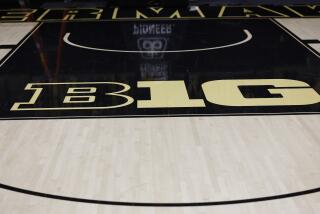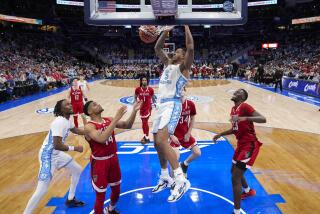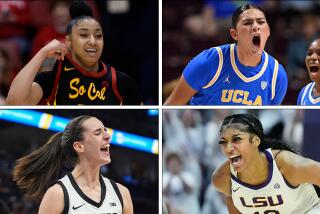Beast Is a Beauty Once Again
The Big East Conference held an impromptu “throwback day” on Feb. 25 that rekindled memories of hip-hugger uniform shorts and Lou Carnesecca sweaters.
When then-No. 3 Connecticut played then-No. 4 Villanova at Philadelphia’s Spectrum, it marked the first time in 11 years that two Big East teams ranked in the top five were meeting.
The game hearkened to a time when the Big East was the beast of college basketball. In the 1985 Final Four at Lexington, Ky., the conference had three of the four finalists--Georgetown, St. John’s and Villanova.
Then, the Big East ruled from a bully pulpit. It called the shots, lowered the boom, dictated to television, held court.
In the 1980s, the conference put eight teams in five Final Fours, five in title games and produced two national champions, Georgetown in 1984 and Villanova in ’85.
Then, slowly, it dried up. The talent, the titles, the tinsel.
Not that many have shed tears, but the Big East has not had a team in the Final Four since Seton Hall qualified in 1989. Thirty-one Big East teams have made the tournament since and none have forged beyond the round of eight.
The conference hit bottom in 1993, when it put only three teams in the NCAA tournament and none reached the round of 16.
But the conference convenes at the Big East tournament, beginning today at New York’s Madison Square Garden, with a major share of the national power.
Three Big East teams are ranked in the top 10--Connecticut, No. 3; Georgetown, No. 6, and Villanova, No. 9. In addition, Syracuse is No. 13 and Boston College only recently dropped out of the top 25.
Theories abound as to what happened to the Big East and its remarkable recovery.
The easiest explanation? Players. In this precarious age of college basketball, when power depends on how long stars stay in school before leaving for the NBA, the Big East lucked out.
The Atlantic Coast Conference lost NBA lottery picks Rasheed Wallace, Jerry Stackhouse and Joe Smith to hardship after last season. The Southeastern lost Antonio McDyess and ScottyThurman.
The Big East kept its stars.
“Only the Big East is really up,” Kentucky Coach Rick Pitino says, assessing the national scene. “What you have now, with everyone leaving early, you have parity because the great ones never develop together. The Big East is up because they have four of the top 10 players in the country.”
When Kerry Kittles of Villanova, Ray Allen of Connecticut, Allen Iverson of Georgetown and John Wallace of Syracuse all decided to stay in school, the Big East became the class of thecountry.
“Clearly, the league is stronger than it was two or three years ago because of depth of talent,” UConn Coach Jim Calhoun says. “I think the marquee players, quite frankly, bring a lot more attention. I’m kind of a believer in the star system. The star system has reallyhelped.”
Other theories:
NOTHING LASTS FOREVER
Like any dynasty--Rome, “Cheers,” the Pittsburgh Steelers--the Big East rose steadily, peaked, then fell off.
“It was virtually impossible to maintain that level forever,” says Boston College Coach Jim O’Brien, in his 10th season. “In those years that people were questioning how good our league was, we thought we had very good competition with good teams. The problem is, when you don’t have the marquee teams, consistently in the top 10, there’s a perception that the league is not that good.”
Georgetown Coach John Thompson subscribes to the theory of cycles.
“I don’t think it’s that big of a deal,” Thompson says of the return of the Big East to prominence. “I think it’s good to talk about. That’s what sport is about. It’s entertaining, discussing who’s ranked, who’s rated. But after you sit and talk about it, sitting in a bar having a drink with buddies, it doesn’t have much validity. Nobody has held onto this thing. That’s the way competition should be.”
THE BIG EAST GOT FAT
The old-timers aren’t going to fess up to this one, but one theory suggests Big East coaches got sidetracked in the 1980s, spending too much time on the rubber-chicken circuit and not enough time landing the players.
The numbers seem to bear this out: In the 1980s, the Big East had 15 consensus first- or second-team All Americans. In the 1990s, there have been four.
“We just went for a three- or four-year period without recruiting the Ray Allen- or Kerry Kittles- or Allen Iverson-type players,” longtime Syracuse Coach Jim Boeheim says. “We’ve had good teams, good balance, good nonconference records in the regular season. We just didn’tfinish at the NCAA tournament ell.”
The resurgence might also have to do with an infusion of fresh faces and ideas. In the 1990s, Steve Lappas replaced Rollie Massimino at Villanova and returned the program to prominence. Brian Mahoney replaced the lovable Carnesecca at St. John’s, and although he has not been a success, he was able to pluck prize recruits such as Felipe Lopez.
The race for players has forced the old guard--Thompson, Boeheim, Calhoun, O’Brien--to step up the pace in recruiting.
The Big East was regarded as a coaches’ conference in its heyday, but Thompson wants to let everyone in on a little secret.
“We had some characters,” he says of the roaring ‘80s. “Me acting like a fool, Rollie acting like a fool, Louie, Jimmy. We had fun getting angry, fun making up. But this has always been a players’ conference. When you don’t have the players, that’s when you hear the swan song about the Big East being down.”
TELEVISION
The dawn of the Big East in 1979 coincided with the rise of an upstart all-sports cable network. It was a perfect marriage. When ESPN started televising Big East games to fill air time, no one thought much of it.
But as ESPN grew, so did the conference, and soon the Big East had a monopoly on air time. It was the first conference to be featured on Big Monday.
No opposing-school recruiter could compete with the Big East’s late-night television exposure.
What changed?
As ESPN expanded in the 1980s, it invited other conferences into its television package, and the Big East lost its recruiting edge.
THUGGERY
People got tired of the Big East’s reputation for rough stuff. They got tired of watching fistfights in the paint, the lack of artistry in the game, the plodding, slowdown tempo.
And then they turned off their TV sets.
The low point was reached when the Big East adopted a six-foul rule in 1990, which only added to the league’s negative image.
The rule lasted three seasons.
While Big East teams were busy nursing bruises and shooting free throws, coaches around the country were moving on to more entertaining, up-tempo basketball--Pitino at Kentucky, Nolan Richardson at Arkansas.
The Big East eventually got the message and dropped its caveman, six-foul rule.
Conference coaches also got with the rest of the country and began playing a faster game,which was attractive to both fans and recruits.
No one know can say how long this Big East resurgence will last.
The conference will lose seniors Wallace and Kittles after this season, and NBA decisions are facing Iverson, a sophomore, and Allen, a junior who Tuesday was named Big East player of the year.
But Boston College’s O’Brien says the Big East is back for good.
“If all indications are accurate, a lot of teams are having good recruiting classes,” he says. “I don’t think our conference will ever go away.”
(BEGIN TEXT OF INFOBOX / INFOGRAPHIC)
Big East in the Big Dance
How conference has fared in NCAA tournament since 1980.
*--*
Year Teams in Field Top finish 1980 3 Final 8 (Georgetown) 1981 3 Final 16 (Boston College) 1982 4 Final (Georgetown) 1983 5 Final 8 (Villanova) 1984 4 Champion (Georgetown) 1985 6 Champion (Villanova) 1986 4 Second round (Georgetown, St. John’s, Syracuse, Villanova) 1987 5 Final (Syracuse) 1988 6 Final 8 (Villanova) 1989 5 Final (Seton Hall) 1990 6 Final 8 (Connecticut) 1991 7 Final 8 (St. John’s, Seton Hall) 1992 5 Final 16 (Seton Hall) 1993 3 Second round (Seton Hall, St. John’s) 1994 6 Final 8 (Boston College) 1995 4 Final 8 (Connecticut)
*--*
Big East Tournament
FIRST ROUND
Today at Madison Square Garden
* No. 8 West Virginia (12-14) vs. No. 9 Seton Hall (11-15)
* No. 4 Syracuse (22-7) vs. No. 13 Notre Dame (9-17)
* No. 5 Boston College (17-9) vs. No. 12 Pittsburgh (10-16)
* No. 7 Miami (14-12) vs. No. 10 Rutgers (9-17)
* No. 6 Providence (16-10) vs. No. 11 St. John’s (11-15)
QUARTERFINALS
Thursday at Madison Square Garden
* No. 1 Connecticut (27-2) vs. West Virginia-Seton Hall winner
* Syracuse-Notre Dame winner vs. Boston College-Pittsburgh winner
* No. 3 Georgetown (24-6) vs. Miami-Rutgers winner
* No. 2 Villanova (24-5) vs. winner of Providence-St. John’s
More to Read
Go beyond the scoreboard
Get the latest on L.A.'s teams in the daily Sports Report newsletter.
You may occasionally receive promotional content from the Los Angeles Times.











